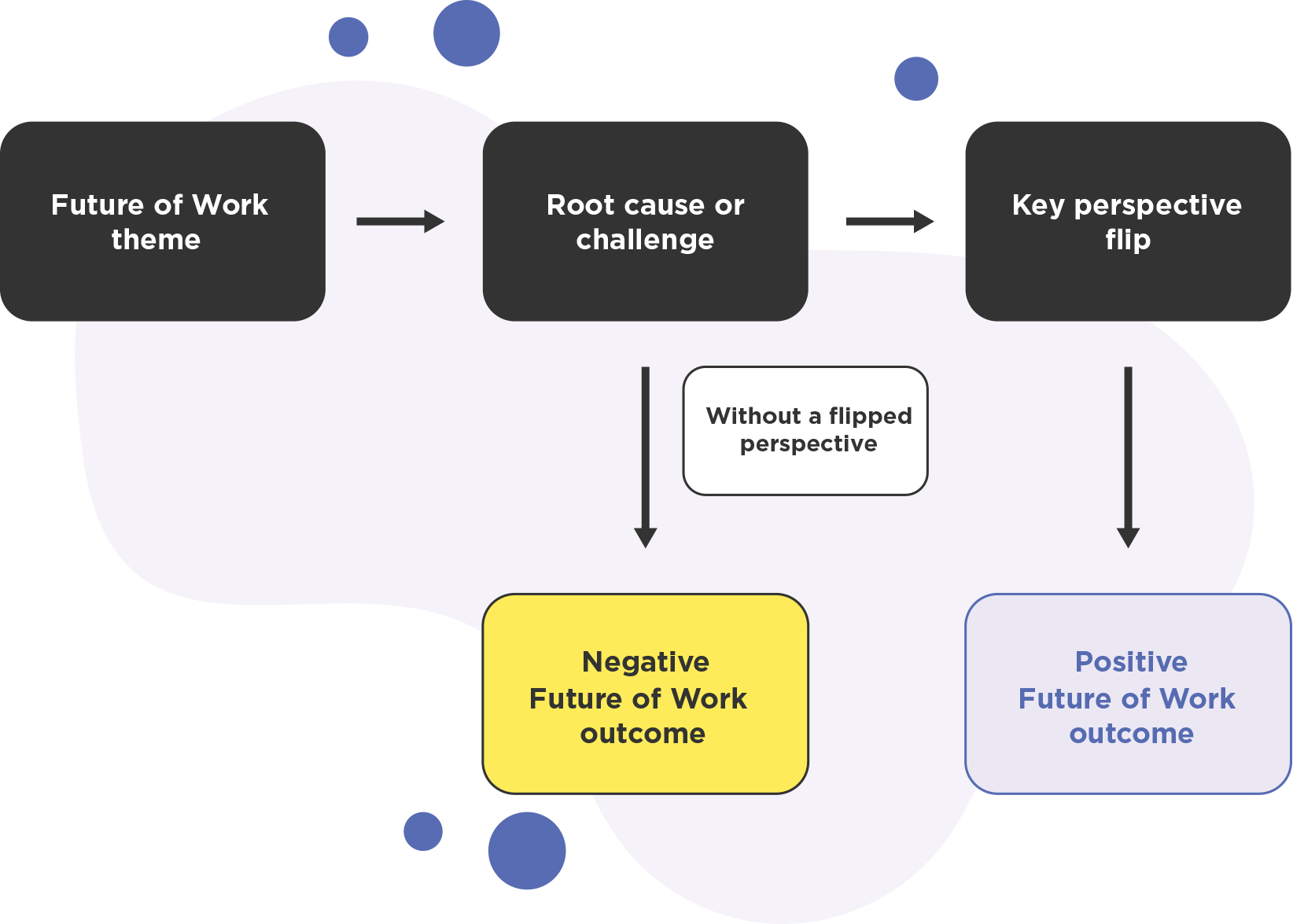The most common narratives being talked about may not help us shape a sustainable Future of Work. We need to dig deeper, flip our perspectives, and ensure our actions have the impact we want.
It certainly seems as if we’ve moved into a post-pandemic world. At the height of lockdowns, people wondered how much of what was being learned in those extreme and unusual times would actually carry forward into the “after times.” Would the lessons of social inequity, work-life balance, and other major issues leave a lasting impression, or would the world return to business-as-usual?
To consider how the world shifted and what has been forever changed, Challenge Factory turned to artifacts from 2020-2023 to help us define key themes that emerged and continue to shape the Future of Work. These artifacts are found in our newsletter.
Every month, Challenge Factory’s newsletter begins with a “flip.” We choose a timely topic making headlines or being talked about by our clients. Then, digging beneath the loudest, most common narrative, we work to identify the perspective or conversation that is going unnoticed. By applying Challenge Factory’s B Corp values and unique approach to shaping the Future of Work, we strive to help our community think creatively, consider new possibilities, and become curious.

Figure 1. The “finding the flip” process.
The process of finding the flip is a learning tool for both the Challenge Factory team and everyone we engage with. It fosters the much-needed skills of asking better questions, questioning assumptions, and assuming a deeper issue or insight can be found beneath the surface. This is crucial today, when employment, careers, and workforce challenges are as complex as they’ve ever been, and what we do (or don’t do) can mean the difference between making incremental, small improvements and creating a sustainable future for all.
The theme of this issue of Workforce Architecture is, itself, the beginning of a flip. The assumption that “no one knows” desperately needs flipping. It is a belief that, left on its own, reinforces the opposite of what Challenge Factory stands for. Realizing this led us to consider our newsletter flips anew. It pushed us to explore if there might be more insight to be gained from them, especially as we reflect on pandemic experiences and lessons learned.
We created a dataset of 16 monthly flips, eight from 2022 and eight from 2023, and mined it for new trends and insights. From this analysis, we identified five popular Future of Work themes that need perspective flips, as well as the outcomes that may result if leaders and changemakers do or do not apply these flipped perspectives (Figure 1).
As you read the Future of Work themes, root causes, flipped perspectives, and outcomes below, ask yourself: Which root causes or challenges might I benefit from learning more about? What impact could I have—in my workplace or community—if I integrated a focus on “finding the flip” into my work or when I’m scrolling through media feeds? How does the positive or action-focused flip change how I feel about the headline; does it make me feel more hopeful?
5 Future of Work themes that need perspective flips
1
Future of Work theme: Labour shortages and mismatches within labour markets
Root causes or challenges: Assumption that “no one knows” where to find talent or how to predict future needs
Key perspective flip: We know where workers are and what they are doing. We’ve solved the puzzle. The causes of labour shortages can be identified and understood, even when they are complex. What remains out of reach is the collective will to solve critical workforce problems.
Positive Future of Work outcome: The causes of labour shortages are acknowledged and accepted. Labour markets rebalance and find equilibrium. We move on to tackling the system-wide challenge: decent work and jobs.
Negative Future of Work outcome: The causes of labour shortages continue to be treated as an unsolvable puzzle with key pieces missing. We carry on asking where all the workers have gone and miss the more difficult questions we need to face. The system-wide challenge of providing decent work and jobs to all goes unaddressed, leading to increases in underemployment and unemployment, precarious work, poverty, income inequality, economic stagnation, mental health struggles, and erosion of social cohesion.
2
Future of Work theme: Canada’s ageing workforces and population
Root causes or challenges:
- Ageism
- Wasted potential
- Skills and knowledge gaps about hiring and career development
Key perspective flips:
- We need to redefine “how old is old” and fight for our future selves today so they don’t experience ageism tomorrow.
- An increased lifespan is long-life potential.
- An ageing workforce is not a problem. It’s the opposite. It’s a hidden talent pool sitting untapped by organizations.
- A new career and life stage has emerged: the Legacy Career®.
Positive Future of Work outcome: Ageist stereotypes and practices no longer affect the quality of intergenerational workforces, career paths, or personal well-being. Everyone can transition into a fulfilling Legacy Career® of their choice with the support of effective, lifelong career development. Companies leverage the talent pool of older workers for a competitive advantage.
Negative Future of Work outcome: Ageism continues unabated. As the population ages, the negative effects of ageist stereotypes and practices increase in proportion and severity. Pensions, housing, and other social support systems collapse. All generations experience the consequences.
3
Future of Work theme: Company policy changes that are presented as permanent even as underlying circumstances continue to shift
Examples:
- Work-from-home and return-to-the-office mandates
- 4-day versus 5-day work weeks
- Recession planning
Root causes or challenges: Culture and leadership
Key perspective flips:
- What matters most isn’t the specific policy, change, or announcement. Policy decisions all start with culture and leadership. What matters most is an organization’s values and people.
- “Either/or” thinking limits the potential of our work and impact. It forces us to align our values and needs in artificial ways.
- Instead of imposing top-down team and culture-building activities on staff, foster bottom-up rituals.
- In times of crisis, treating people-related programs as discretionary is a costly mistake.
Positive Future of Work outcome: Values are aligned between organizations and their people, and business success follows. Workplace values and culture are discussed openly and intentionally. People-related programs have become essential spending and their ROI is recognized. We stop positioning every decision as an all-or-nothing trade-off, opening the door to new creativity and finding common ground for ideas to flourish without needing complete agreement. Changing policy is seen as an iterative process that develops over time in response to changing conditions and new data.
Negative Future of Work outcome: Employee engagement declines and turnover is high. Business costs associated with talent attrition increase. Leadership succession planning fails.
4
Future of Work theme: Radical and unpredictable change across work, workplaces, and workforces
Examples:
- Changes in expectations and behaviour caused by the pandemic
- Unstable labour markets and economies
Root causes or challenges: Disruption, uncertainty, and a lack of confidence in how to navigate them
Key perspective flips:
- The pandemic didn’t change everything.
- The talent revolution was already causing seismic shifts in the world of work before the pandemic. Revolutionary change follows predictable patterns. We can still make sense of changing careers, workplaces, and labour markets using Future of Work drivers that were already known.
- We already have the tools and processes needed to succeed and thrive during disruption and uncertainty.
Positive Future of Work outcome: We don’t needlessly reinvent the wheel, building sustainable approaches to work even when disruption, uncertainty, and change feel overwhelming. We use existing tools, processes, and knowledge to foster resilience and confidence, while pursuing new data for informed decision-making.
Negative Future of Work outcome: We waste time, effort, and other resources rediscovering tools and processes we already had before crisis hit. Work, workforces, and business success suffer. The next crisis hits, and we begin the cycle all over again. We never address broader needs and challenges because we’re continuously operating in crisis management mode.
5
Future of Work theme: The volume and complexity of challenges feel unsolvable
Examples:
- Recession fears and predictions
- Cumulative effects of the pandemic
- Retirement age and pension system changes (such as in France, leading to mass protests)
- Related, though not represented in the newsletter dataset: Fear about the impact of generative AI and other technologies
Root causes or challenges:
- Erosion of trust in leaders and institutions and the social contract between them
- People are lonely and gaps in support remain common
Key perspective flips:
- Unrest and upheaval about specific topics across society or within companies, like changes to the retirement age or return-to-office mandates, aren’t the story. The real story is about what happens when trust in leaders and institutions breaks down.
- In a world where the question of trust feels beyond complicated, recognizing someone’s courage can be simple and powerful. What if we stopped trying to earn trust and instead focused on taking courageous action?
- Even with the renewal in time spent together after the pandemic, we need to intentionally foster community, including peer support and formal career guidance.
- Not everything needs to be better for you to feel better.
Positive Future of Work outcome: We regularly reaffirm our capacity to affect change—as individuals, organizations, and communities. Both leaders and community members of all stripes focus on demonstrating courage, trust follows organically, and better solutions to tough challenges are created together. We prioritize relationships over tasks, peer support over transactions, and reflection over easy answers.
Negative Future of Work outcome: We only dwell on what is going wrong in our work, organizations, or careers. It is cathartic in the moment, but prevents real change, connection, and positive impact. Isolation and loneliness increase. The social contract breaks down between citizens and governments, and between employees and organizational leaders.
Analyzing Challenge Factory’s newsletter “flips” led to three valuable takeaways
1. The flips show just how central people are to solving workforce challenges and shaping a sustainable Future of Work. They are what will always matter—connections, relationships, and community. Technology is not a theme in these flips. Humans are.
2. Finding flips helps us regularly consider purpose and impact. Action and inaction have consequences. Impact can be measured. Thinking through short- and long-term changes can clarify purpose and direction today, transforming us into active agents who create the work, careers, organizations, and future we want tomorrow.
3. Successfully navigating complexity rather than being overwhelmed by it depends on having reliable, intentional processes for developing solutions, problem-solving, and decision-making in ‘normal times’ and in times of crisis. This is evident in what the flipped perspectives and potential outcomes tell us about the challenges we’re facing, as well as in the process of how the flip is found: moving from the headline topic or theme to the root causes to the flip to the potential outcomes of action or inaction (Figure 1).
